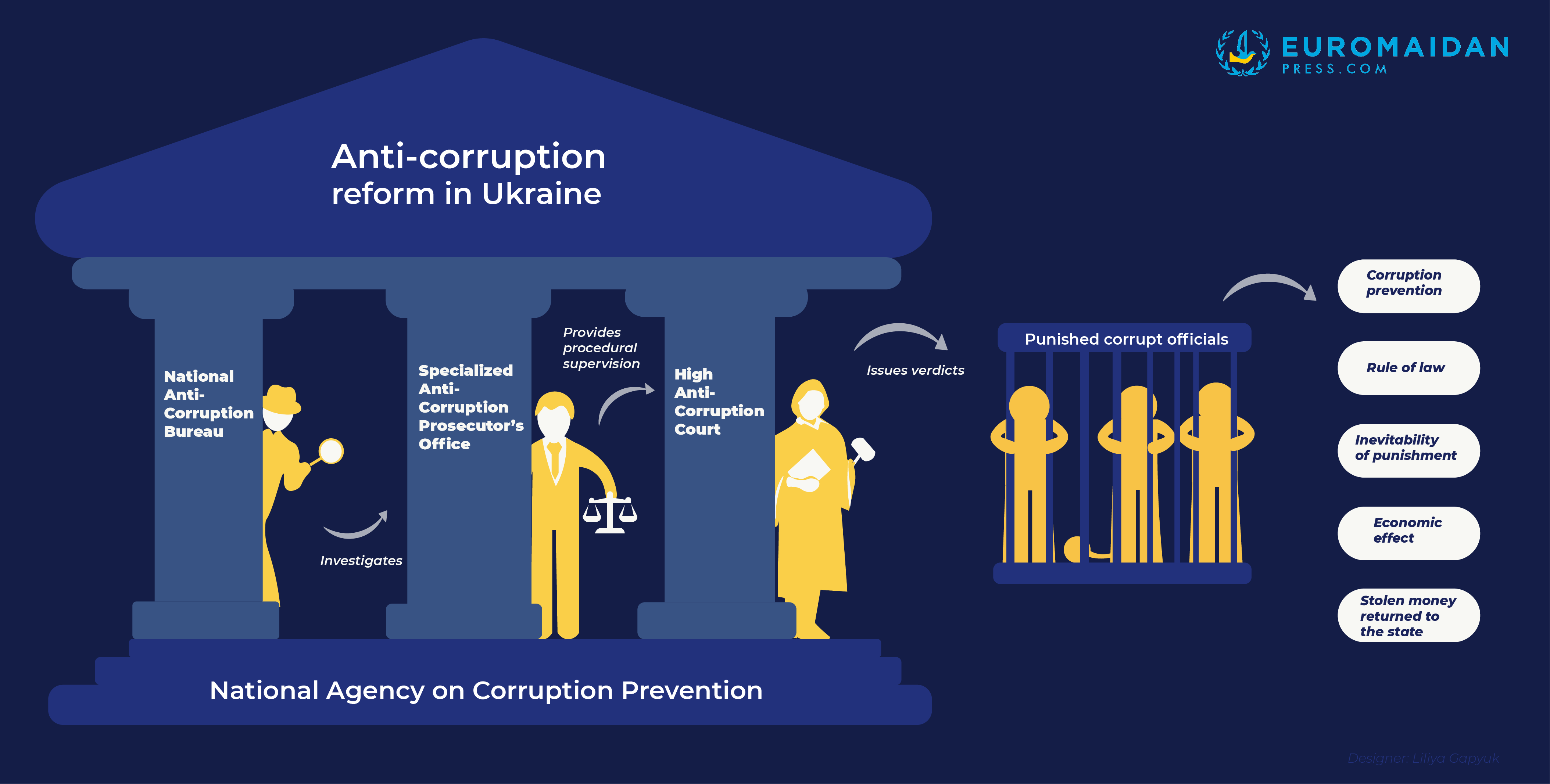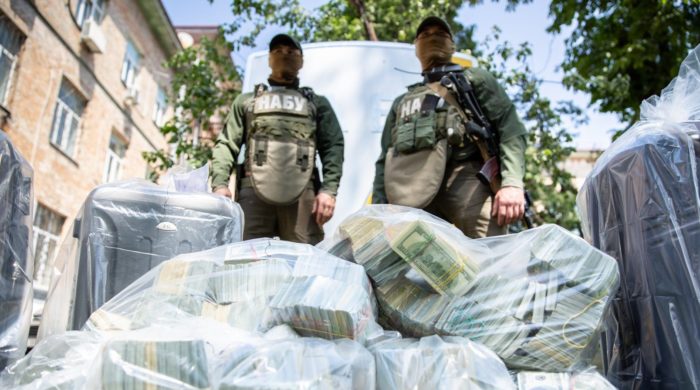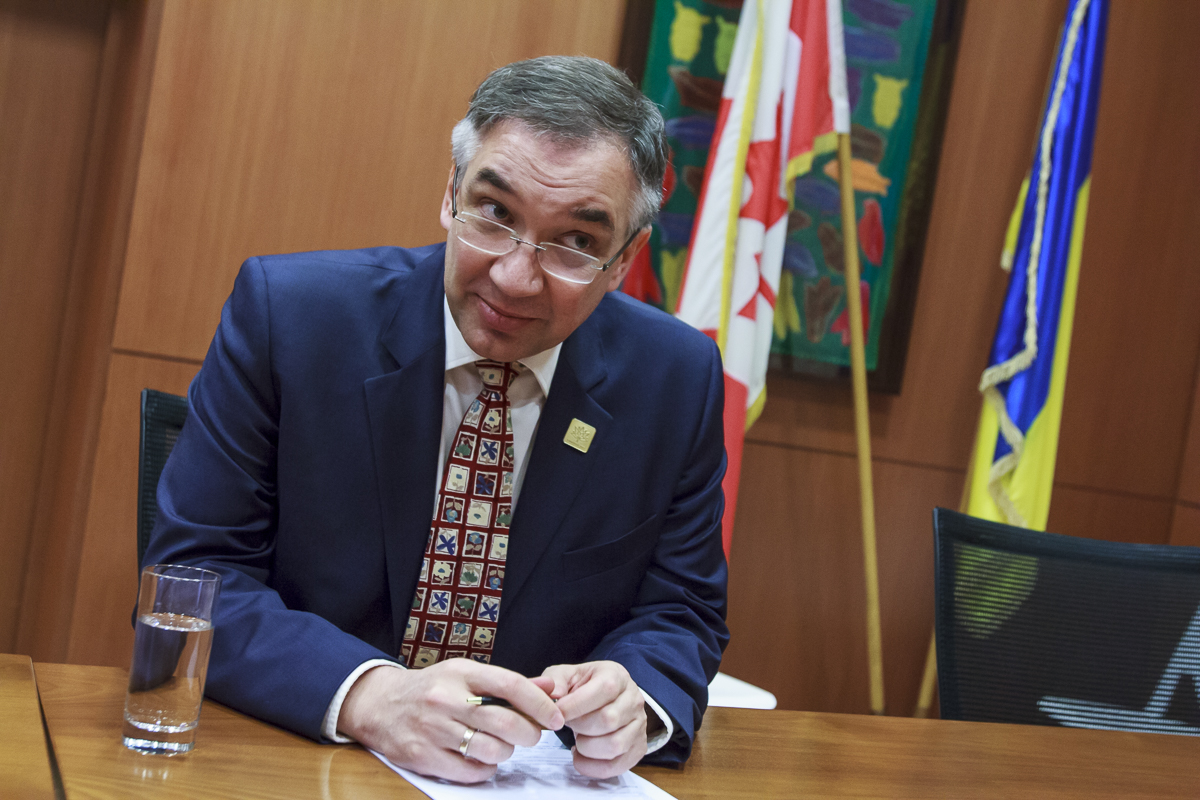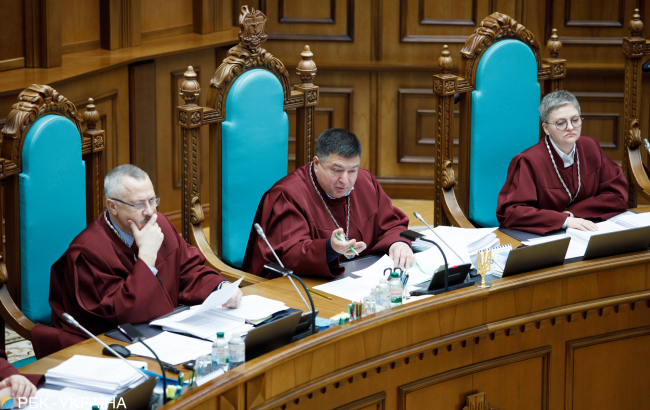- Reporting on reforms in Ukraine that commenced after the Euromaidan Revolution has often been rather negative, with successes observed during the first years after the revolution being rolled back and stagnating. Also, many people say that the fight against corruption is a second frontline for the country, which to some extent is true. However, Ukraine’s successes in the anti-corruption direction are often underestimated.
Significant processes whose results are already visible or will be in the future have been launched. In particular, Ukraine has built a chain of anti-corruption bodies that have broken the stalemate on the country’s anti-corruption front.
Euromaidan Press talked to Vadym Valko, Automaidan NGO lawyer, and Secretariat of the National Anti-Corruption Bureau’s Public Control Council analyst to evaluate the results of the changes in the anti-corruption direction.
The creation of the new anti-corruption institutions in the country started in 2015. Amongst the first was the Anti-Corruption Bureau (NABU) responsible for investigating cases categorized as top-level corruption, the Specialized Anti-Corruption Prosecutor’s Office (SAPO) responsible for the procedural supervision of the cases, and the National Agency for Corruption Prevention (NAZK), responsible for the development and implementation of the national anti-corruption policy.
The last of the three had - at least until Autumn 2019 - a very bad reputation, being blamed for inefficiency and political dependence.
In Autumn 2019, the new parliament relaunched the body, which soon delivered positive results, examples of which are a draft project on the new anti-corruption strategy and an improved format of asset declarations for state servants.

Infographic: Liliya Gapyuk / Euromaidan Press The last anti-corruption body created in Ukraine was the High Anti-Corruption Court, the necessity of which became obvious when the NABU and SAP started to direct its cases to ordinary courts where they were held up. The High Anti-Corruption Court, made up of 38 judges and created especially for cases of top-level corruption, started operating on 5 September 2019.
So why is the creation of all of these bodies considered a success?
Before the NABU, high-profile corruption cases were not investigated in the country

Mykola Martynenko, used to be one of the untouchable persons in Ukraine until in 2017 the NABU opened a case against him accusing him of embezzlement. Martynenko is a key figure in Ukrainian politics who preferred to stay in the shadows. He is also the main player of Ukraine’s uranium market. Photo: Serhii Nuzhnenko, RFE/RL Before the creation of the Anti-Corruption Court, Ukrainian media tended to discredit the NABU as it was blamed for a lack of prosecuted individuals. In fact, the NABU as an investigative body has never been responsible for it, as convictions or acquittals are the responsibility of courts where the cases on top-level corruption were stalled.
Valko stresses that before the NABU and SAP existed Ukraine had never seen such high-profile investigations. Among them are the cases against the “grey cardinal” of Ukraine’s political scene Mykola Martynenko, the former head of the State Fiscal Service Roman Nasirov, Odesa mayor Hennadiy Trukhanov, and many others.
However, calculating success is complicated.
“If looking at the amount of the stolen funds returned to the budget, it is not much,” Valko says.
Still, the analyst points out other benefits the NABU delivers:Firstly, it has a preventive function, as those looking at other cases being investigated would think twice about committing such a crime themselves.
Secondly, Valko points to the economic benefit. Corruption schemes investigated by the NABU which siphoned off millions over years have been eliminated, ending the harm they do to the country.
Also, one of the aspects of the economic effects is in terminating harmful agreements between state enterprises and private companies. Thanks to the decisions on these terminated agreements, state enterprises have been armed with the legal right to file independent lawsuits to have the funds returned.
“The NABU terminated agreements to the amount of UAH 8bn ($292m). During a period of five years, about UAH 2.5bn ($91m) was spent by the NABU. If state enterprises were dealing with it [working on extracting the funds], the NABU would be paid off only due to these agreements. These are not even investigations. This is much easier.”
However, as a rule state enterprises were not dealing with getting money returned - the private companies in question would not be able to pay since they were fictitious.
The more verdicts in the NABU cases appear, the more stolen funds are expected to be returned to the budget. However, Valko stresses that law enforcement bodies are not business.
“It’s not like you invested and they were paid off. They have other functions. They are about the rule of law and the inevitability of punishment.”
In general, the NABU’s establishment was a breakthrough in Ukraine’s anti-corruption efforts. Before it was set up, the discussion on fighting corruption in the country had not been so acute and politicians drowning in corruption fed their potential voters with empty promises of prosperity and stability. The NABU proved that even the so-called “untouchables” are not immune to investigation.
Institutions are strong even if there are questions over their heads

The head of the Specialized Anti-Corruption Prosecutor’s Office Nazar Kholodnytskyi (left), the head of the National Anti-Corruption Bureau Artem Sytnyk (right). Photo: nabu.gov.ua Since the beginning of their work, the NABU and SAP have been headed by Artem Sytnyk and Nazar Kholodnytskyi respectively. The procedures of the selection of both differed, but both were public. The NABU head is appointed for seven years, while the head of the SAP for five.
Kholodnytskyi had to leave in November but had announced his resignation at the end of August 2020. Previously, society had lots of questions about his work as there were signs of him sabotaging cases.
- Read also: Ukraine’s main anti-corruption prosecutor keeps office despite gross violations of professional ethics
- Divorce of Ukrainian anti-corruption institutions: will it affect the investigations against top-corrupts?
“Still, Kholodnytskyi himself is not the SAP, the SAP is prosecutors. I think the majority of prosecutors are ethical,” Valko says, pointing at the particular investigations into the most corrupt, including MPs, being directed to courts.
The Commission which will select the new head of the SAP consists of 11 people. Four out of them are nominated by the Prosecutor’s Council, while seven are nominated by the Parliament. The four nominated by the prosecutors have already been selected. According to Valko, civil society has no issues with them, unlike the candidates chosen by the Parliamentary Committee on Law Enforcement. The parliamentary vote on them is expected in September.
Valko adds that the public procedure of selecting the SAPO head was a condition for the EU visa-free regime for Ukraine. Non-fulfillment of it might lead to its suspension or cancelation.
There have been questions about the NABU head Sytnyk as well, and even a minor corruption scandal with his involvement as Sytnyk found himself in the registry of persons having committed corruption or corruption-related offenses. This related to him not having paid UAH 25,000 (about $900) for accommodation during his vacation. The incident sparked attempts by the NABU’s opponents to have him dismissed.
Despite these points, Valko judges Sytnyk more positively and emphasizes the importance of the working institution’s creation.
“The good body with 700 employees able to investigate high-profile cases was created from scratch. No single case of a NABU detective taking a bribe was identified. This is also an indicator. I think that all the other law enforcement bodies were chasing the NABU detectives to catch them. But there were no such cases.”
The analyst says that the personality of the head itself is not that important as the body will be able for some period to keep the quality of the institution no matter who heads it.
Moreover, the role of the head of the NABU is overestimated.
“The head of the detectives' department is the head of the criminal process. He is the head of this body of the pre-trial investigation, while Sytnyk holds an administrative position.”
The expert is confident that despite Sytnyk having two years left, numerous attempts to remove him are to be expected.
“He bothers lots of people. Which is a positive sign.”
Valko explains that so far today committing an offense related to corruption is not among the reasons to dismiss the NABU head. However, MPs registered a bill according to which a person who committed such an offense has to be dismissed, although the provision itself violates the principle of law not having a retroactive effect in time.
While this article was in progress, Sytnyk’s opponents came closer to unseating him with a decision of the Constitution Court of Ukraine.The court ruled that past president Petro Poroshenko’s appointment of Sytnyk to the head of NABU after a competition in 2015 was unconstitutional. MPs appealing to the court stated that Poroshenko had gone beyond his purview, as the Constitution does not foresee the president appointing the NABU head.
The Constitution indeed does not foresee such an option, which means that the legislation on NABU indeed contradicted Ukraine’s main law, but was adopted nonetheless. This, according to constitutional expert and deputy head of the Center for Political-Legal Reform Roman Kuibida, was a “time bomb” which was prone to erupt sooner or later.
However, the Constitutional Court can’t dismiss Sytnyk; rather, the ruling invalidated the decree with which he was appointed. Practically, this means that decisions signed by Sytnyk from now on could be appealed in court, which will probably lead him to avoid signing anything. However, NABU will still continue working, with the deputy director assuming Sytnyk’s duties. The situation may be resolved by changing the law on NABU or the Constitution, while the only person who can dismiss Sytnyk is the president, believes Fedir Venislavskyi, the president's representative to the Constitution Court of Ukraine.
Reacting to the court decision, NABU released its own statement calling it politically motivated and related to NABU's recent investigation into the work of the Kyiv District Administrative Court, which has exclusive powers to consider cases of top state bodies located in Kyiv. The NABU suspected the judges of this court of creating a criminal organization and aiming to seize state power. The investigation included uncovering political interest in some of the Constitutional Court decisions as well.
So far, it is unknown how the attacks on the NABU through attempts to unseat Sytnyk will end. Even if he is removed, NABU’s institutional capacity will permit continuing to implement its duties on a decent level. However, it is obvious that further offensives on the institution are expected in the future. Therefore, public control over the processes around the NABU becomes crucial.
No major complaints against the court after a year’s work

The High Anti-Corruption Court was created in particular for cases of top-level corruption investigated by the NABU and the SAP. The procedures involved in its creation included the participation of international experts which contributed to its fairness.
After a year of work, the court has taken 16 decisions, 15 of which were convictions. So far there have been no major claims of court judges lacking independence. The corrupt officials whose cases had already been investigated tried to avoid consideration of their cases in the newly-created court as it became clear to them that the machinations which would have been possible in other courts would not work in the High Anti-Corruption Court.
Among the challenges the court faces, Valko names the number of judges.
“There are lots of cases, but not that many judges. Out of the 38 judges of the court, there are only 18 who conduct hearings. A number of others are investigative judges, others work in the appeal chamber. The specifics of the cases on top corruption is that there have to be three judges conducting the hearings. 18 judges mean six collegiums. Each collegium considers about 30 cases. There are 22 working days in a month. Two cases can be considered a day. So objectively big cases consisting of 200-250 books each should be considered for about a year and a half.”
The expert says that it is hard to explain all the complexity of the consideration of cases in the court to a wider audience. Thus Ukrainians have until now been rather skeptical towards the court.
Valko estimates that 16 decisions are a decent result for the first year of the court’s work. The first case was ruled in October 2019, less than a month after the beginning of the court’s operation. However, more is expected from the court after the first year of work as the establishing work is over.
“I think at the end of the second year of work there should be eight to ten final decisions since every month new cases are coming.”
Valko praises the transparency and the communication of the court’s work. However, the lack of unbiased media coverage is another challenge the court faces. For example, the case against the above-mentioned grey cardinal Martynenko accused of causing losses to the state of UAH 700m ($26mn) has been systematically covered in a manipulative way by the two nationwide channels Inter and Ukrayina. In their materials, the two hushed up the details, gave the floor only to the defense, and never described the international component of the investigation. Meanwhile, other media only cover key hearings in high-profile cases.
Valko stresses that publicity is important not only for the wider audience but for the judges as well.
“I think that the judges are honest. Even though it's important for them to know that someone is watching them.”
Valko as well as other judicial experts from society emphasizes the importance of scaling the experience of creating the anti-corruption court with the participation of the international experts in the whole judicial system.
While all judges in Ukraine cannot be selected according to a similar procedure, the bodies of judicial self-governance, the High Council of Justice, and the High Qualification Commission of Judges can. So far, the bodies have demonstrated great resistance to the reform. Also their reloading according to the new principles is not foreseen by the new Zelenskyy reform.
- Read also: Corrupt and biased judges still pollute Ukraine’s judiciary; Zelenskyy’s reform will not fix this
The fight for the Anti-Corruption Court in Ukraine had been tough. The pre-Zelenskyy government first resisted the idea in general. When under the pressure of Ukrainian NGOs led by the Anti-Corruption Center and the country's international partners the idea was finally accepted, the fight to make the court independent started. As of now, the court’s establishment can be placed on the list of Ukraine's successes on the anti-corruption front.
Project on anti-corruption strategy finally appeared

The new team of the National Agency for Corruption Prevention. Photo: nazk.gov.ua/ The restaffing of the judiciary is foreseen by a draft of the anti-corruption strategy of the NAZK, another anti-corruption body created from scratch in 2015.
Until autumn 2019, the body was in fact not effective and involved in scandals itself. Its ex-head herself was suspected of corruption.
After the body was relaunched, things went differently. Valko explains that the new department heads are experts from NGOs which had advocated changing the old management of NAZK during the last three years
Among the steps they already managed to take is a new form of asset declarations for civil servants. Also, due to the NAZK efforts, asset declarations of heads of the Security Service of Ukraine have finally been made public.
Valko stresses the importance of the above-mentioned anti-corruption strategy draft.
“We have not had any strategy since 2017. In fact, it is a key document according to which we act.”
The document has been positively received by the professional community, while the bodies of judicial self-governance criticized its parts that outline how they should be reformed.
“They understand this is a threat to them. Therefore, now there is a huge informational campaign against it. In particular, against the part on the judiciary.”
The expert also stresses that, as many interests are involved, it is important for the body to withstand attempts to compromise the strategy.
After its relaunch, the NAZK passed the test of commitment to the reform path. However, the test of being able to withstand political attacks is yet to come.
The cup of the anti-corruption fight is half full
During the last five years, Ukraine proved its ability to establish effective institutions aimed to punish and prevent corruption. Moreover, these institutions proved their efficiency during these years.
However, the risk of a rollback is always there, as the fight against corruption foresees pushing the so-called political elites, both previous and current, out of their comfort zone. The influence of these people in Ukraine is still strong, therefore they will not give up easily.
Still, apart from the punishment and prevention, Ukraine is on the long way of working on eliminating corruption on the level of culture and on the level of bringing up political elites with a new mindset aimed at developing the country, not stealing from it.





